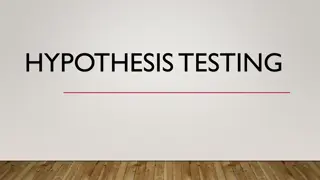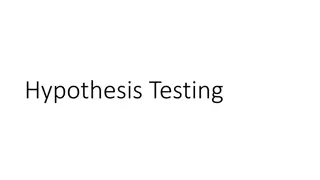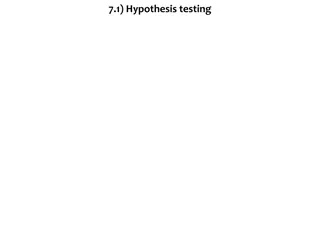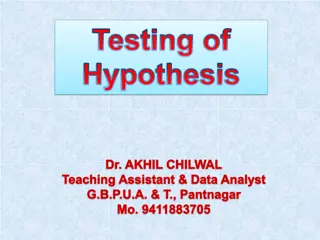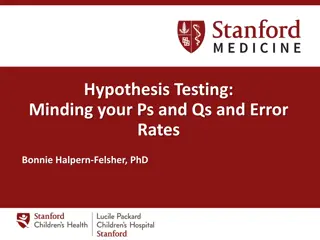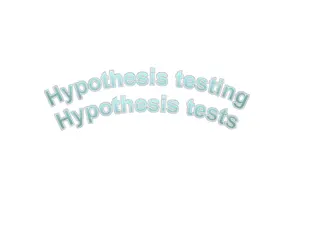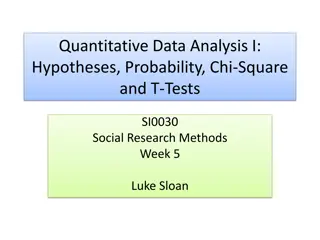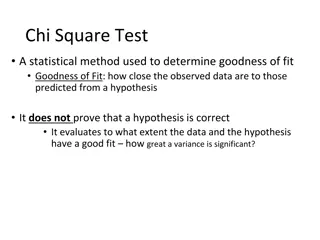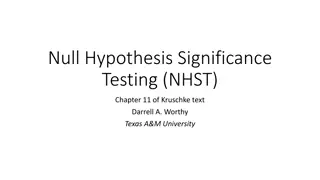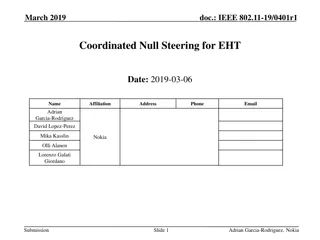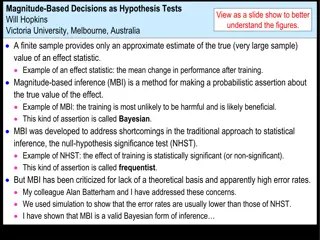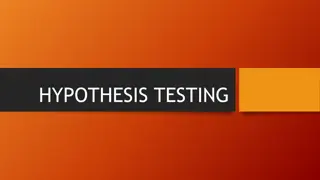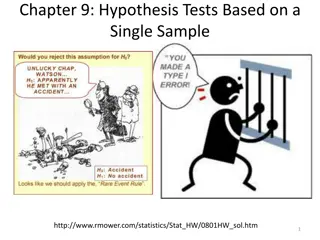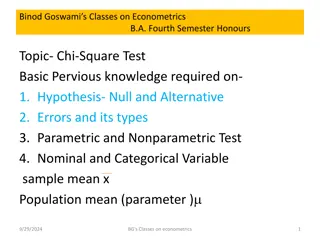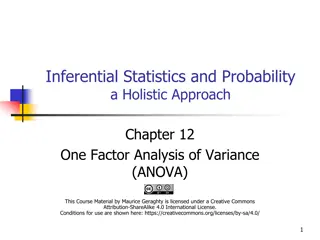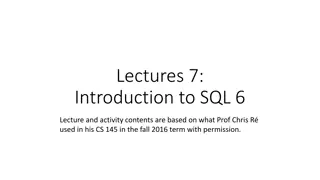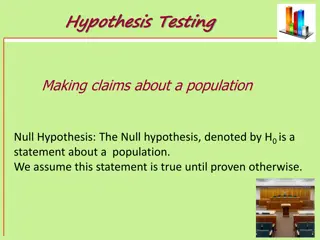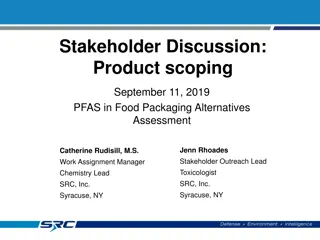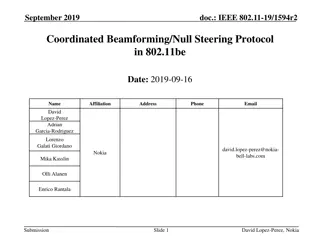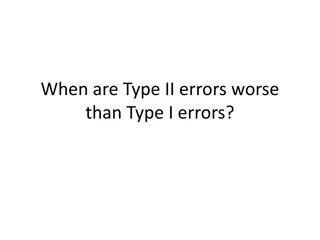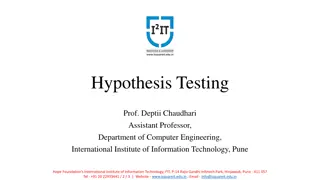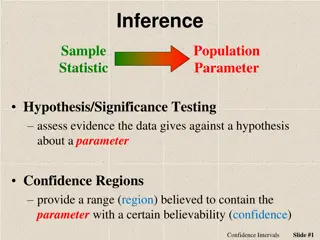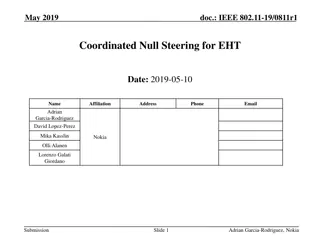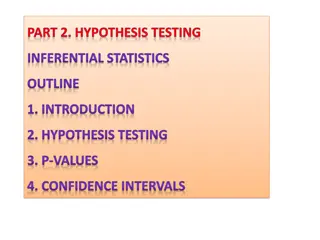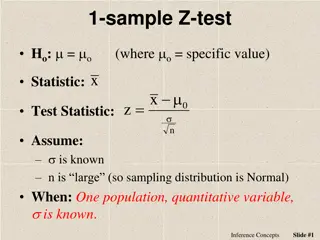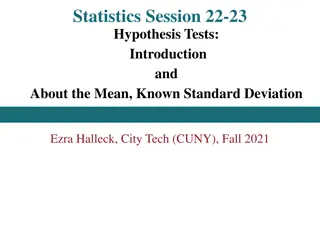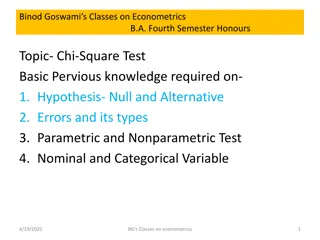Bayesian Estimation and Hypothesis Testing in Statistics for Engineers
In this course on Bayesian Estimation and Hypothesis Testing for Engineers, various concepts such as point estimation, conditional expectation, Maximum a posteriori estimator, hypothesis testing, and error analysis are covered. Topics include turning conditional PDF/PMF estimates into one number, es
2 views • 16 slides
Type I and Type II Errors in Hypothesis Testing
In statistics, Type I error is a false positive conclusion, while Type II error is a false negative conclusion. Type I error occurs when the null hypothesis is incorrectly rejected, leading to a conclusion that results are statistically significant when they are not. On the other hand, Type II error
1 views • 6 slides
Hypothesis Testing and Null vs. Alternative Hypotheses
A hypothesis is a prediction about a study's outcome, guiding research direction. Stating hypotheses forces deep thinking and making specific predictions but may introduce bias. Null hypothesis (H0) states no effect, while alternative hypothesis (Ha) claims an effect in the population. Researchers e
0 views • 7 slides
Hypothesis Testing Examples and Scenarios
Explore various scenarios involving hypothesis testing, including coin bias, dice rolling, and election candidate support estimation. Learn to define test statistics, null and alternative hypotheses, select significance levels, and determine conditions for rejecting the null hypothesis based on samp
0 views • 9 slides
Hypothesis Testing in Statistical Analysis
Statistical analysis aims to make inferences about populations based on sample data. Hypothesis testing is a crucial aspect where decisions are made regarding accepting or rejecting specific values or parameters. Statistical and parametric hypotheses, null hypotheses, and decision problems are key c
2 views • 34 slides
Hypothesis Testing in Statistics
Hypothesis testing is essential in scientific inquiry, involving the formulation of null and alternative hypotheses at a chosen level of significance. Statistical hypotheses focus on population characteristics and are tested on samples using probability concepts. The null hypothesis assumes no effec
0 views • 26 slides
Hypothesis Testing: Examples and Interpretation
This content covers various examples of hypothesis testing scenarios, including car drivers' preferences for turning directions, the effectiveness of a new drug compared to a standard treatment, and the probability of seeds germinating in a greenhouse. It explains how to formulate null and alternati
0 views • 11 slides
Hypotheses, Probability, and Statistical Tests in Social Research
This content delves into formulating hypotheses in social science, selecting statistical tests based on variables' measurement levels, understanding probability in statistical analysis, and distinguishing between null and alternative hypotheses. It emphasizes the research process involving hypothesi
6 views • 21 slides
Chi-Square Test for Goodness of Fit
Chi-square test is a statistical method used to assess how well observed data match the predicted values from a hypothesis. It does not confirm the hypothesis but measures the extent of fit between data and the hypothesis. This test is crucial for determining the significance of differences between
0 views • 10 slides
Null Hypothesis Significance Testing (NHST) in Statistics
Null Hypothesis Significance Testing (NHST) is a common method in statistics to determine if a particular value of a parameter can be rejected, such as testing if a coin is fair. This involves calculating probabilities of outcomes and p-values to make decisions. The process relies on defining spaces
0 views • 37 slides
Coordinated Null Steering for Enhanced Wireless Communication
Null steering in wireless technology allows devices to place spatial radiation nulls towards non-served STAs for interference suppression, improving spatial reuse and mitigating inter-cell interference. This document discusses null steering-related proposals in EHT, including challenges, benefits, a
0 views • 16 slides
Magnitude-Based Decisions in Hypothesis Testing
Magnitude-based decisions (MBD) offer a probabilistic way to assess the true effects of experiments, addressing limitations of traditional null-hypothesis significance testing (NHST). By incorporating Bayesian principles and acknowledging uncertainties, MBD provides a robust framework for drawing co
1 views • 22 slides
Herding Nulls and Other C# Stories From the Future
Explore the challenges of dealing with nulls in C#, including expression of intent, enforcement mechanisms, and solutions to ensure null safety within the existing language. Learn how to differentiate between nullable and non-nullable types, protect non-null types from nulls, and strike a balance be
1 views • 16 slides
Hypothesis Testing in Statistics
Hypothesis testing is a fundamental concept in statistics that involves testing statements about population parameters. This content covers the basics of hypothesis testing, including types of hypotheses, examples, and the procedure involved in statistical hypothesis testing. It also explores the im
0 views • 23 slides
Hypothesis Testing in Statistics
This content discusses the fundamentals of hypothesis testing based on a single sample in statistics. It covers the assumptions for inference, the parts of a hypothesis test, statistical hypotheses, and provides examples of hypothesis tests and significance tests in practical scenarios. The importan
1 views • 69 slides
Hypothesis Testing and Types of Errors in Econometrics
Hypothesis testing is vital in econometrics to evaluate statements about population parameters. The null hypothesis assumes no difference, while the alternative hypothesis offers a different perspective. Different types of errors—such as Type I and Type II errors—can occur during hypothesis test
2 views • 11 slides
One Factor Analysis of Variance (ANOVA)
One Factor Analysis of Variance (ANOVA) is a statistical method used to compare means of three or more groups. This method involves defining factors, measuring responses, examining assumptions, utilizing the F-distribution, and formulating hypothesis tests. ANOVA requires that populations are normal
0 views • 23 slides
Plant Chemistry and Phytonutrients: Insights from Research
Exploring the diverse world of plant chemistry, this content delves into primary and secondary metabolites, highlighting the significance of phytonutrients in maximizing nutritional content. Various hypotheses such as the Insecticide Hypothesis and Co-evolution Hypothesis are discussed, shedding lig
0 views • 61 slides
SQL Concepts: Quantifiers, NULLs, and Handling Null Values
Dive into the world of SQL with this content, covering essential concepts such as quantifiers, NULLs, and how SQL handles null values. Explore topics like existential and universal quantifiers, handling NULL values in numerical and boolean operations, and understanding the behavior of NULL values in
0 views • 18 slides
Hypothesis Testing
Hypothesis testing involves making claims about a population, such as the null hypothesis assumption and testing against sample data. Learn about examples of testing drug effectiveness and student heights in Ireland.
0 views • 5 slides
Hypothesis Testing
Hypothesis testing is a key aspect of statistical analysis, involving the formulation of null and research hypotheses, understanding p-values, errors, significance, and more. Learn about different types of hypothesis testing, common statistical tests, steps in hypothesis testing, and how to interpre
0 views • 30 slides
Visualization Basics and Statistics Hypothesis Testing
This content covers topics on Visualization basics, statistics basics, exploring penguins dataset, scatter plots replication, merging plots, hypothesis testing, and more. It discusses concepts like null hypothesis, alternative hypothesis, p-values, significance levels, and standard deviation. Explor
0 views • 12 slides
Penguins Visualization and Statistical Hypothesis Testing
This content covers various topics related to penguins, including visualization basics, statistics basics, exploring penguins dataset, scatter plots, merging plots, and hypothesis testing. It delves into how different penguin species are represented in scatter plots and discusses the process of hypo
0 views • 9 slides
Coordinated Beamforming/Null Steering Protocol in 802.11be
This document discusses the coordinated beamforming/null steering protocol in IEEE 802.11be, highlighting the challenges and benefits of joint transmission/reception. The protocol aims to efficiently realize gains in coordinated beamforming/null steering, presenting a viable solution for AP coordina
0 views • 15 slides
When Type II Errors Outweigh Type I: Explained
In statistical analysis, knowing when Type II errors are more detrimental than Type I errors can be crucial. This highlights scenarios where accepting a false null hypothesis can have more serious consequences than rejecting a true null hypothesis. Understanding this nuance is key for informed decis
0 views • 21 slides
Hypothesis Testing
Hypothesis testing is a crucial aspect of statistical analysis, where hypotheses are formulated, tested, and conclusions are drawn regarding parameters. This process involves setting null and alternate hypotheses, determining p-values and significance levels, and understanding Type I and Type II err
0 views • 11 slides
Handling Null References in Object-Oriented Programming
Null references play a crucial role in programming, where objects are assigned special values to signify non-existence. Understand how to manage null references effectively to prevent errors and improve code reliability. Explore examples of using null references in object assignments and method call
0 views • 35 slides
Hypothesis Testing in Statistics: Understanding Testing Procedures
Hypothesis testing is a fundamental method in statistics to validate assumptions about population parameters. This process involves formulating null and alternative hypotheses, selecting significance levels, identifying test statistics, and making decisions based on sample evidence. By following a s
0 views • 15 slides
Hypothesis Testing in Statistics
Hypothesis testing is a fundamental statistical method used to investigate and make decisions based on experimental data. It involves formulating null and alternative hypotheses, selecting a level of significance, identifying test statistics, and applying decision rules. By following a five-step pro
0 views • 5 slides
Statistical Significance of Earnings Data Analysis
The statistical significance of earnings data analysis, including hypothesis testing based on outcome variables, comparison group considerations, and hypothesis formulation. Learn about setting up null and research hypotheses, selecting appropriate test statistics, and creating visualizations in Tab
0 views • 28 slides
Hypothesis testing
Explore hypothesis testing in statistics including the process of formulating null and alternative hypotheses, conducting tests, and interpreting results. See examples involving binomial distributions and multiple-choice testing. Understand the significance of critical regions and significance level
0 views • 15 slides
The Null Curriculum: Theoretical Basis
This essay critically examines the concept of the "null curriculum" in education, focusing on its definition for theory and practice. It discusses the role of conceptions of curriculum in defining the null curriculum and its practical applications in curriculum development and evaluation.
0 views • 33 slides
Understanding Inference and Hypothesis Testing in Statistics
This content covers essential concepts in statistical inference, hypothesis testing, confidence intervals, and the scientific method. It explains the difference between null and alternative hypotheses and provides examples to illustrate their application in real-world scenarios. Through visual aids
0 views • 9 slides
Coordinated Null Steering for Enhanced Wireless Technology
Explore the concept of null steering in wireless technology, its benefits, challenges, and proposals in Enhanced Wireless Technology. Learn about the coordinated null steering approach and its effectiveness in interference suppression and spatial reuse.
0 views • 16 slides
Understanding Hypothesis Testing in Inferential Statistics
Dive into the world of hypothesis testing in inferential statistics, where descriptive statistics fall short. Learn the difference between a hypothesis and hypothesis testing, the steps involved, and the significance of p-values and confidence intervals in testing relationships and variations betwee
0 views • 36 slides
Inference Concepts: Hypothesis Testing for Introverts' Close Friends
Explore a hypothesis test assessing if the mean number of close friends for introverts differs significantly from the general U.S. population. Using a 1-sample z-test with known population standard deviation, data analysis reveals a rejection of the null hypothesis and supports the investigator's pr
0 views • 7 slides
Advanced SQL Concepts and Handling NULL Values
Explore advanced SQL concepts such as INTERSECT and EXCEPT, Three-Valued Logic, and working with NULL values. Understand how to deal with unexpected behaviors in SQL queries due to NULL values. Learn about explicit joins and left outer joins in SQL for more efficient data retrieval.
0 views • 21 slides
Hypothesis Testing Procedures and Cases: Understanding Mean and Standard Deviation
Explore hypothesis testing procedures including p-value and critical-value approaches, different cases based on known standard deviation, and how to calculate z-values for sample means. Understand when to reject null hypothesis based on p-values in various scenarios.
0 views • 16 slides
Understanding Hypothesis Testing in Econometrics: Overview and Types
Explore the world of hypothesis testing in econometrics, focusing on null and alternative hypotheses, errors in testing, and different types of hypothesis statements. Gain insights into the significance of statistical techniques like Chi-Square, T-test, and F-test in validating hypotheses.
0 views • 8 slides
Understanding Hypothesis Testing in Statistics
Learn about hypothesis testing in statistics, including the definition of a hypothesis, the process of testing hypotheses, types of statistical hypotheses, null hypothesis, examples, and more. Dive into the world of data analysis with this comprehensive guide.
0 views • 34 slides

